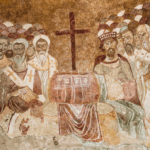In anticipation of some more theological reflections on Easter, here are some observations about its basic historicity.
Scholars and apologists often point to the Easter resurrection as the most important piece of historical evidence for the truth of Christianity. That of course, is right and proper—Paul himself uses it (1Cor 15:5-7). But I think there are some other little bits of evidence in the Easter story that are persuasive in other ways. Here are seven odd and incidental details that that point to the eyewitness origins of the Gospel accounts.
1. Mystery Streaker
And a young man followed him, with nothing but a linen cloth about his body. And they seized him, 52 but he left the linen cloth and ran away naked. (Mark 14:51-52)
The first strange detail comes from Mark’s inclusion of a note about one of the disciples who loses his clothes and flees the scene of Jesus’ arrest naked. None of the other Gospels include this incident, which isn’t surprising because it doesn’t really add anything to the story. Speculations that Mark was describing himself here make good sense. But, whether that’s the case or not, it’s hard to imagine any reason why such a peculiar and distracting detail would be made up except that it happened.
2. Insider Knowledge
Then Simon Peter, having a sword, drew it and struck the high priest’s servant and cut off his right ear. [The servant’s name was Malchus]. (John 18:10)
All four Gospels record the attack on the high priest’s servant, but only John mentions his name. Why? The simplest explanation comes five verses later when we learn that Peter gains access to the high priest’s courtyard through “another disciple” who was known to the high priest. This is the writer, (typically) trying to avoid making an explicit self-reference. But if he had access to the high priest’s household, it makes perfect sense that he should know the name of one of its members.
All four Gospels record the attack on the high priest’s servant, but only John mentions his name. Why? Because he knew him.
3. A Gospel Cross-Reference
“We heard him say, ‘I will destroy this temple that is made with hands, and in three days I will build another, not made with hands.’” 59 Yet even about this their testimony did not agree. (Mark 14:58-59)
This detail is interesting because it seems to come out of the blue. None of the synoptic Gospels (Matthew, Mark, Luke) record Jesus saying any such thing, yet both Mark and Matthew make it a key item of evidence in Jesus’ prosecution (and later, a taunt flung at him while he is dying on the cross c.f. Mark 15:29; Mark 27:40). Yet John’s Gospel gives us the source. After his first cleansing of the temple, Jesus makes an oblique reference to his own resurrection by saying that he will raise up the temple [of his own body] after they destroy it (John 2:19-22). In Mark and Matthew, the crowds have garbled and misunderstood this to mean that Jesus’ will destroy the Jerusalem temple and rebuild it.
4. Too Much Information About Simon
And they compelled a passerby, Simon of Cyrene, who was coming in from the country, the father of Alexander and Rufus, to carry his cross. (Mark 15:21)
Simon of Cyrene is another incidental character who appears in the story with unnecessary and distracting detail. Why are we told his name? Who cares about his destination? Why on earth does Mark bother to mention his sons? The simplest explanation is that Simon is a known church member and that his children are more immediately known to the generation for whom the evangelist is writing. If Mark was written in Rome, as tradition suggests, Rufus may be the guy mentioned in Romans 16:13.
5. The Evidence of Counterevidence
So they took the money and did as they were directed. And this story has been spread among the Jews to this day. (Matt 28:15)
When Matthew tells us the story of the tomb-guards being paid-off to keep silent about the resurrection, it doesn’t prove that Jesus rose, but it does seem to point to a real controversy that needed to be addressed. If there were no empty tomb, why would there be a need for the Jewish authorities to explain it; or for Matthew to provide counterevidence?
6. John First, No, Peter First
So Peter went out with the other disciple, and they were going toward the tomb. 4 Both of them were running together, but the other disciple outran Peter and reached the tomb first. 5 And stooping to look in, he saw the linen cloths lying there, but he did not go in. 6 Then Simon Peter came, following him, and went into the tomb. (John 20:3)
Here’s more detail that seems to do little but get in the way of the story. Is John trying to account for a discrepancy between two verbal accounts of the resurrection? (c.f. John 21:23) Possibly, but either way, the level of detail only makes sense if the person writing it is recounting actual events he witnessed firsthand.
7. Two For One
Peter turned and saw the disciple whom Jesus loved following them, the one who also had leaned back against him during the supper and had said, “Lord, who is it that is going to betray you?” 21 When Peter saw him, he said to Jesus, “Lord, what about this man?” 22 Jesus said to him, “If it is my will that he remain until I come, what is that to you? You follow me!” 23 So the saying spread abroad among the brothers that this disciple was not to die; yet Jesus did not say to him that he was not to die, but, “If it is my will that he remain until I come, what is that to you?” (John 21:20-23)
This last incident is a two-for-one. We get the rumour that needs to be scotched as in Matthew 28:15 but we also get the cinematic detail of John 20:3-6. Both point to real events involving real people, and real traditions coming from those events.
Easter Literary Witness
Of course, these kinds of details are all through the Gospels once you start to look for them (try it!). Although we haven’t featured Luke in this selection, we could make some similar observations about his account of the other end of Jesus’ life and how it includes a lot of detail that only Mary herself could have known.
These are subtle yet powerful scraps of evidence. In response to liberal theologians who try to write-off the Gospels as myths, C.S. Lewis observes that myths don’t come with this level of detail—modern novels and eyewitness reportage do:
I have been reading poems, romances, vision-literature, legends, myths all my life. I know what they are like. I know that not one of them is like this. Of this text there are only two possible views. Either this is reportage … Or else, some unknown writer in the second century, without known predecessors, or successors, suddenly anticipated the whole technique of modern, novelistic, realistic narrative. If it is untrue, it must be narrative of that kind. The reader who doesn’t see this has simply not learned to read.[1]
Lewis is right. The four evangelists were writing to us about things that really happened. Jesus really died. He really rose and appeared to the disciples. Our faith is not in vain.
[1] From “Fern-seed and Elephants” (1998); originally entitled “Modern Theology and Biblical Criticism”—delivered at Westcott House, Cambridge, 11 May 1959.















